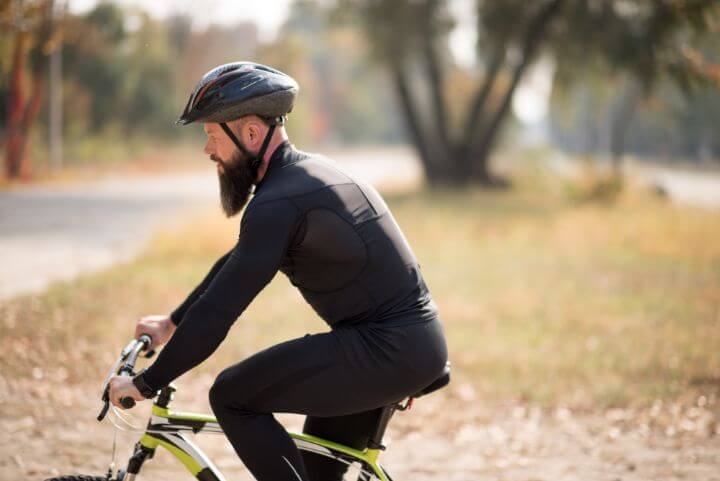Are you a cyclist wondering when to get back to bike riding after your scheduled knee replacement surgery? Or, are you non-cyclist thinking about whether bike riding is a safe exercise after your knee surgery?
If you are either, let us tell you that bike riding can be done after knee replacement surgery and that too safely and soon enough.
During your rehabilitation, cycling on a stationary bike initially and later using an outdoor one is one of the best exercises.
You have to pay attention to some small details while you do so.
Here is your complete list of all tips and precautions you need to follow when you finally plan to get back on your bike after your knee surgery.
Tips
#1 When You Start – Go Slow!
You have just come out of knee surgery. The last thing you want is to put stress on your knees. So we suggest you start gradually.
Give yourself a few weeks to let the pain and swelling settle down. The recovery time is different for different people and could be anywhere from 4 to 6 weeks. To reduce the pain make sure to elevate your legs with a knee pillow and apply an ice pack.
You have to increase your range of knee movement gradually. Do not try to rush it if you feel you are not ready.
You may also like Recliners After Knee Replacement Surgery
#2 Be Consistent in Your Physical Therapy
Physical therapy is crucial during the recovery phase after your knee surgery. It may start as soon as 24 hours after the surgery.
Follow the instructions of your physical therapist honestly. You shall start your training by walking on a flat surface, followed by climbing stairs.
Gradually, you would increase your range of movement through a continuous passive motion (CPM) machine. This machine is used to slowly flex (bend) and extend your knee to relieve knee joint stiffness.
You will be given an exercise schedule by the physiotherapist when in hospital. Even after discharge from the hospital, continue your physical therapy at home as well.
The more active you stay, the sooner you will get back to your bike riding.
You might also like Best Sleeping Positions After Knee Replacement Surgery
#3 Begin Training on a Stationary Bike
When you are comfortable increasing your range of motion, you can start cycling gradually on a stationary bike before hopping onto an outdoor one. Consult your surgeon when to start. Most people can begin nearly six weeks after surgery.
Keep the following points in mind.
- Placement – Place the stationary bike on a flat surface for stability and balance.
- Seat height – Adjust the bike seat height while you sit on it. Your knees should be bent slightly when the pedal is at its lowest point.
- Motion – Slowly start cycling in the reverse direction at first for a few minutes. You may not be able to do a full rotation initially when pedaling. Just move the pedal up to where it is comfortable and hold your knee in that position for a few seconds. Once you are comfortable pedaling reverse, start in the forward direction in the same manner. Next, do both reverse and forward pedaling alternately for a few minutes.
- Time – Maintain this routine daily till your range of motion increases which usually happens within a few days.
#4 Add Resistance to Increase Your Range of Motion
After you can crank the pedal to a full rotation, your next step is to add some resistance to your movement. The resistance further increases the knee movement range and helps build muscle strength.
Speak to your therapist about how much resistance you can add when you start.
- You can increase the resistance setting on your stationary cycle. It will add necessary resistance to your cycling movement. Keep the resistance level comfortable so that it does not cause pain.
- You can ask someone to hold the pedal of the cycle while you push it down. It is another way of resistance training while cycling.
A little discomfort on adding resistance is normal. However, let your therapist know if it becomes painful.
You might also like Best Age for Knee Replacement Surgery
#5 Outdoor Bike Riding
After you have completed your resistance training on a stationary bike, you can gradually shift to outdoor bike riding with your favorite mountain bike/hybrid bike/road bike.
It can be done when your knees can bend 90 degrees while pedaling on a stationary bike. Your physiotherapist shall help you measure this. He can then advise you if you can begin outdoor bike riding.
- Start riding slowly on flat ground first.
- Ride on mild inclines only after a few days of pain-free riding.
- Keep increasing your range of movement while riding slowly without putting any stress on your knees.
- Avoid sudden jerky movements.
- Stop or slow down as soon as you feel any pain.
It brings us to a few points that you need to keep in mind as precautions. These will help prevent any damage to your knees while working to achieve cycling-fit strength during your rehabilitation.
Precautions
- The most important precaution is to not rush through the rehabilitation process. Your body needs to take its due time to recover and come back to its fit self to begin cycling.
- Do not fall for hear-say during your recovery period. Follow the instructions of your surgeon and physiotherapist honestly.
- Do not skip physiotherapy on a stationary bike and try to cycle directly on an outdoor one. Pedaling on a stationary bike is one of the most passive and mild exercises that you can begin with to increase your range of motion of the knee.
- At any time during cycling, do not give sudden jerky movements to your knee. Your pedaling should be gradual, slow, and smooth.
- If, while riding a bike, you begin to feel some pain, you must not forcefully push yourself to do it. It is better to stop and ask your physiotherapist for guidance.
You might also like Preparing for Knee Replacement Surgery – All You Need to Know
Summary
Staying active post-surgery is essential for increasing your range of movement while also building strength in the knees.
Both recovery and rehabilitation after knee replacement surgery take time. Do not lose patience. Be consistent in your efforts and do the same under professional guidance.
Always begin with a stationary bike before graduating to a regular one.
Progress will take time. But with honest dedication from your end, you will start riding a bike soon enough after your knee surgery.
We also give guidance for those who like to do other activities including driving, yoga, skiing, hiking, and running after knee replacement surgery.



